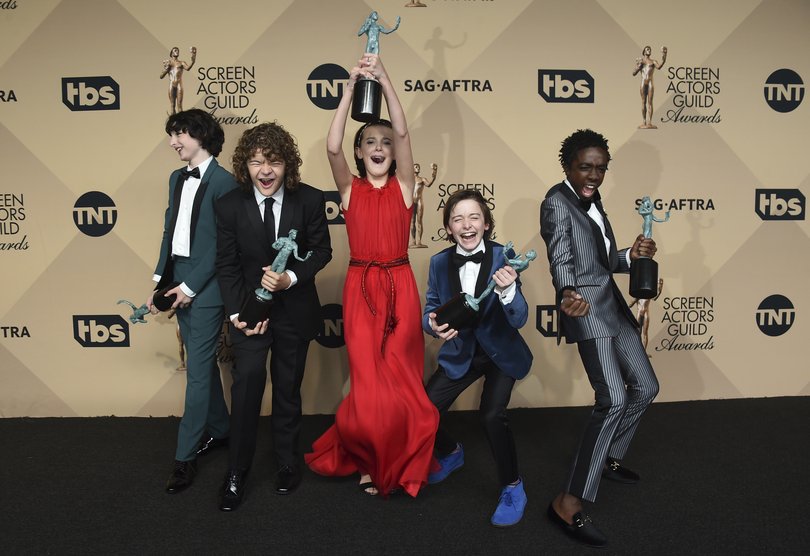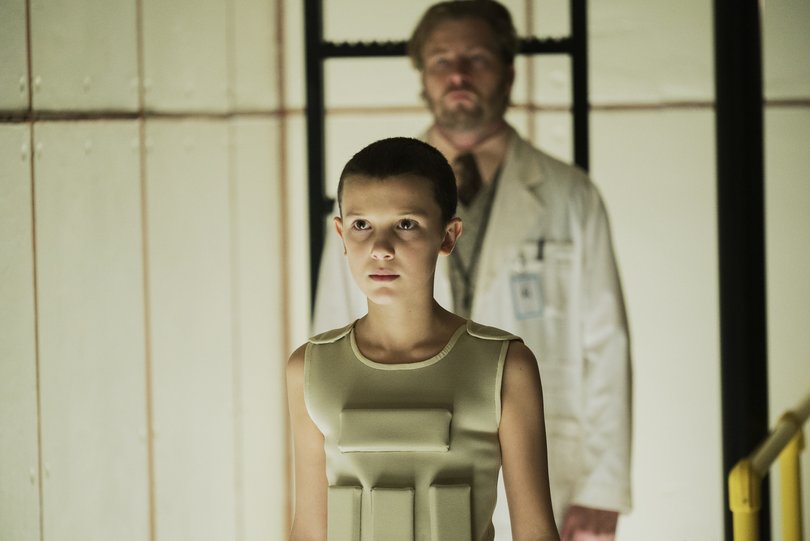Stranger Things season five marks more than the end of the show, it’s the end of an era for Netflix

Since the start of the month, an old show (well, old for Netflix) has been climbing its way back up the streamer’s most-watched charts.
In the first week, it was just the first season of Stranger Things, but now, as time drew closer to the most anticipated series return this year, all four of the fantasy epic’s previous instalments are in its top 10.
Part of that is it has been three and a half years since the most recent episode, and memories are a little fuzzy, but the other part is that since its release in July 2016, Stranger Things is Netflix’s biggest franchise.
Sign up to The Nightly's newsletters.
Get the first look at the digital newspaper, curated daily stories and breaking headlines delivered to your inbox.
By continuing you agree to our Terms and Privacy Policy.Not in raw numbers, because, technically, Wednesday and Adolescence rank first and second above it, and yes, they’re huge, obviously, but the zeitgeist is more than stats.
Take, for example, the Avatar movies, which are number one and three on the list of highest-grossing movies of all time, not adjusted for inflation, and yet have had very little cultural relevance over the past 15 years.
The only reason the first three seasons of Stranger Things isn’t in Netflix’s all-time top 10 is they were released when the streamer had far fewer subscribers (83 million when the first season premiered versus 301 million at the end of 2024, the last time it reported numbers), and by its own metric, it only counts views and hours watched during the first 91 days after release.
So when we say the biggest, we’re talking in terms of brand recognition, fan fever, and cultural penetration, and on those counts, Stranger Things reigns.

There are many reasons why it does. It was the exciting and scary adventure on which the show’s core group of kids – Mike, Dustin, Lucas, Eleven and later Max – found themselves as they tried to rescue their friend Will from the clutches of a hell dimension.
It was also multi-generational with select adults – Joyce and Hopper – wise to the strange supernatural goings-on that everyone else seemed intent on ignoring, and older teen characters – Nancy, Steve, Jonathan and, later, Robin – which gives audiences yet another entry point into the ensemble.
It was the production design of the 1980s small-town America setting, with its retro spaces, such as that era-specific shopping mall in volume three, or this season’s pirate radio station. All of which evoked the nostalgia of four decades ago, also meticulously served through the costumes and music.
Ah, the music - the synth-heavy score, the Kate Bush song Running Up That Hill, which re-entered the charts thanks to Stranger Things and the subsequent viral videos on TikTok, but also huge 1980s tracks including Foreigner, KISS, Talking Heads, Bon Jovi, The Romantics, Toto and The Who.
It also happened to be pretty well written, directed and performed, the shaky second season notwithstanding. It’s been nominated for 57 Emmys, winning 12.
This fifth season, or at least the first three episodes made available for review, continues that legacy and delivers more of what fans already love in scares, adventure and big emotions, but even darker.
Stranger Things creators, twin brothers Matt and Ross Duffer, 41, are kids of the 1980s who grew up on movies such as The Goonies and Stand By Me, so they’re not cynically evoking the era because it would sell: it’s authentic to their own childhood memories.
When you genuinely love something, it’s much easier to bring people along with you – and they have.

The show’s fanbase is enormous, and they are effusive, especially the younger generations who have grown up with the series’ core cast from pre-teens to young adults, although it is a show with wide demographic appeal.
Whenever they can, they show up in costume, with homemade art and purchased merch, cameras poised and voice boxes ready to scream.
In the first few minutes after season five was released at midday AEDT, according to reports, the demand was so high, the service crashed, even though Ross Duffer had earlier revealed that Netflix had increased its bandwidth by 30 per cent to accommodate the anticipated interest.
The final season’s press tour resembled that of the biggest movie blockbusters, with the cast and the Duffer brothers calling on London, Berlin, Tokyo and Los Angeles while other major cities also hosted significant fan activations.
In Australia, over two nights this week, an enormous screen was erected adjacent to the Sydney Harbour Bridge, in effect showing the series’ villains, a Demogorgon and Vecna, ripping through space against the iconic landmark.
There’s also a ticketed fan experience in Sydney’s Luna Park in which participants are plunged into their own Stranger Things storyline (without the life-and-death peril) as well as activations and themed food (Scoops Ahoy ice cream!), drinks and merchandise.
Stranger Things has been critical to Netflix’s brand expansion beyond TV shows and movies. Because of the series’ high-concept, immersive sci-fi and fantasy world-building, it naturally lends itself to real-world experiences.
It also spawned a successful stage production in the West End and Broadway called Stranger Things: The First Shadow, a prequel story which delves into the history of Henry Creel, the human who became Vecna, the show’s Big Bad.
There are numerous video games as well as an upcoming animated spin-off, which follows the adventures of the kids, set between seasons two and three.
The capacity for Stranger Things to branch out beyond the original series mirrors Netflix’s own ambitions in terms of making its brand stickier.

While the ultimate goal is for either new customer sign-ups or for subscribers to remain loyal, there’s plenty of ancillary revenue from selling T-shirts and fluffy toys, or food at various activations around the world, including the streamer’s now-open Netflix House in the US state of Philadelphia.
It’s not quite Disneyland, but who says it can’t be, eventually?
To do that, you have to have titles that are strongly associated with your brand, and, in some ways, Stranger Things is Netflix and Netflix is Stranger Things, and not just because both their signature colours are red, although that doesn’t hurt.
If you build goodwill with your customers, they’re less likely to cancel when Netflix raises prices on its subscriptions, as it did most recently in Australia in August.
When consumers look at the cost every month, for $9.99 with ads to $28.99 for its premium tier, you don’t want them to remember that a decade ago, the promise was $8.99 for everything, ad-free.
Of course, everything was never the case, and there were always different tiers, but those nascent days had a glow. It’s harder to keep that glow when you’re no longer the plucky upstart trying to bring value, but the dominant force in a mature market.
Signature shows like Stranger Things are critical in maintaining that halo effect. Netflix has plenty of new series and films out every week, but the vast majority of them are middling and forgettable slop, so it needs stand-out titles to stick in people’s minds.

So, what is Netflix without Stranger Things?
This fifth and final season will be released in three batches – four episodes today, three more on Boxing Day, and the series finale on New Year’s Day – and once it’s done, it’s the end. Not just of the show, but also of its relationship with the Duffers, who will decamp to Paramount to reunite with Cindy Holland, the former Netflix executive who commissioned the series a decade earlier.
The brand extensions will go on, as Netflix - not the Duffers - owns the rights. But this still closes a chapter, not just for Stranger Things but the company itself.
When Stranger Things debuted in 2016, Netflix had been in the originals game for four years after it identified - correctly - that the licensing market would become less reliable as rival studios would inevitably launch their own comparable products and wall off their pipeline.
The streamer had released about two dozen originals by then, and Stranger Things joined a stable which included the likes of The Unbreakable Kimmy Schmidt, Master of None, House of Cards, Sense8 and Narcos.
At that point, it hadn’t even cancelled anything, with the exception of Lilyhammer, which was technically its first original, but a co-production with Norwegian and German companies.
It was the golden years when bold, original ideas with creative ambitions were the guiding light of its commissioning strategy instead of the volume game. When you’re the disruptor, you have to do things differently, or at least try to be the best, which at that point was HBO.
Now, it’s about being a little something to everybody, which ends up being not much of anything. There is no longer a sense that Netflix stands for anything.

Stranger Things is its oldest narrative series by a long way, and with its end, the last vestige of that earlier time.
Netflix is also light on ongoing shows that occupy a similar status, and nothing that has the same wide appeal.
Squid Game wrapped up earlier this year, and the mooted American remake has gone quiet, while the less said about the dreadful reality competition spin-off, the better.
Wednesday, Netflix’s most-watched series by numbers, is likely two years off another season, and doesn’t have the same cross-generational attraction as Stranger Things - at least not anecdotally.
Bridgerton will return with its fourth season in early 2026, and with eight instalments in the book series it’s adapted from, there’s plenty of life left. But it’s 18 months to two years between seasons, so they’re not churning them out fast enough, and Bridgerton, a costume drama focused on romance, largely skews female.
The Monster series rates well in numbers, but many audiences are increasingly queasy about its gratuitous depiction of serial killers and their crimes, and it unsurprisingly triggers a different discourse than the all-out love Stranger Things engenders.

Maybe Netflix is already in pre-production or on the hunt for something that will replicate Stranger Things’ template, but it’s a different time in the streaming game.
Netflix is diversifying with live events such as WWE, sports, gaming and podcasts, and no one is throwing around the silly money that they were a handful of years ago, now that the onus has shifted from growth to profitability.
Stranger Things wasn’t hugely expensive, relatively, to start with. However, by the end, according to Puck, each episode was costing north of $US50 million.
The conditions aren’t right for another Stranger Things to come along. Maybe Netflix doesn’t need one. Maybe it doesn’t need the halo effect, or to be loved.
When the Hawkins crew, hopefully, inevitably, defeats Vecna and sets the world rightside up again, it really is the end of an era in more ways than one.
Stranger Things is streaming on Netflix.

